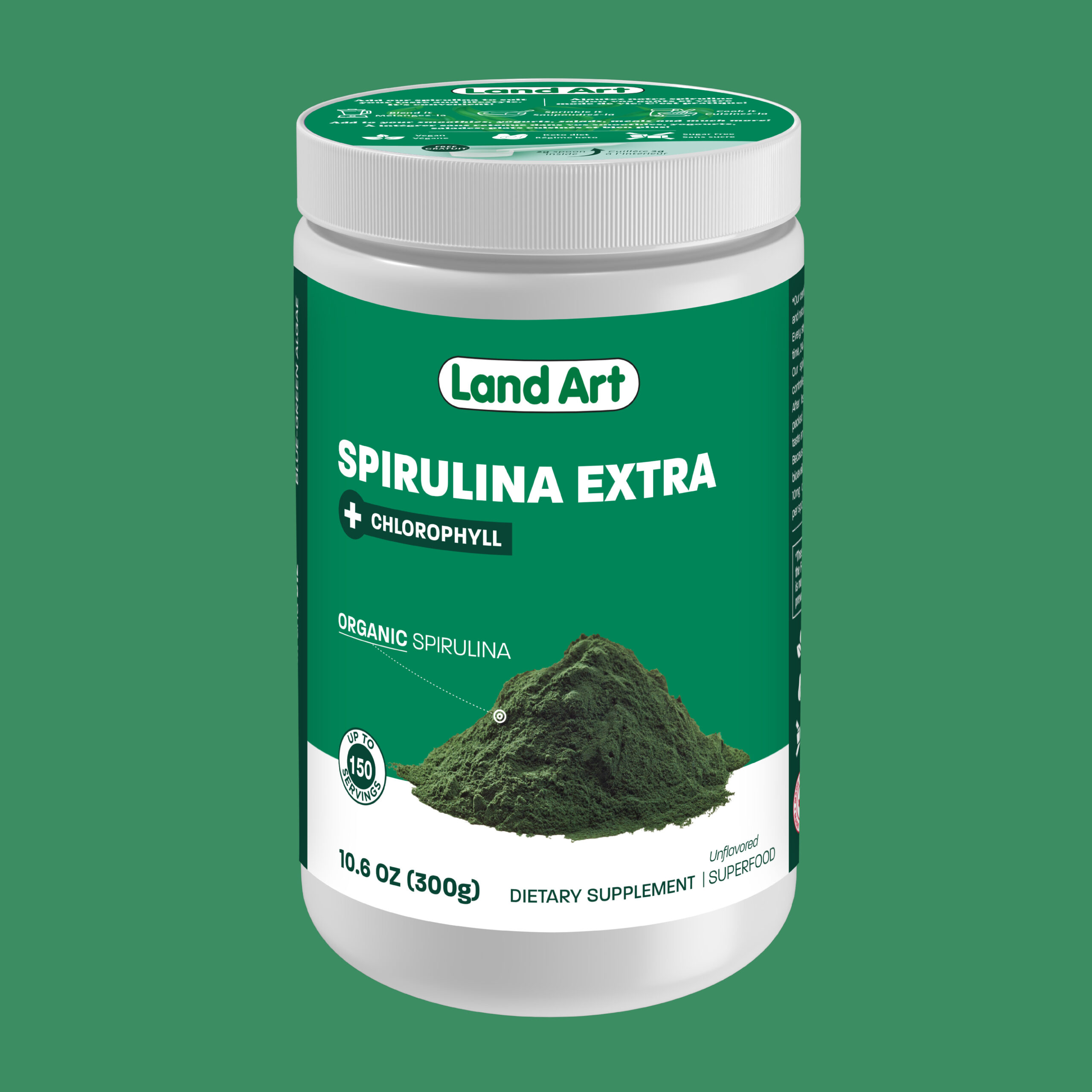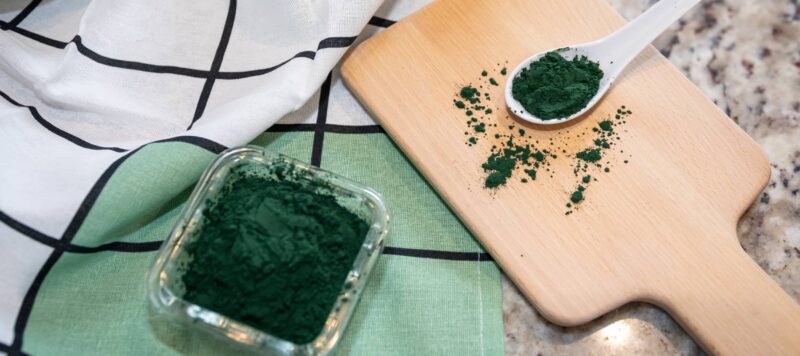By Nicolas Martineau, B.Sc.
Declared in 1974 by the World Health Organization (WHO) as the best food of the future, spirulina continues to astonish researchers for its nutritional values, health benefits, and its ability to thrive in diverse and extreme environments such as space. Indeed, this microalgae is already used by NASA and the European Space Agency astronauts to enhance their nutritional intake. Research is even underway to assess its production on board spacecraft.
Already harvested and used as food by the Aztecs, the Mayans, and various African populations for hundreds of years, spirulina not only helps prevent famines but can also be consumed daily to improve our health.

Numerous studies began in the 1960s, and it was quickly found that spirulina was one of the most concentrated and complete foods available. Spirulina is rich in proteins, vitamins, minerals, polysaccharides, and polyunsaturated lipids.
- PROTEINS: In fact, 60 to 70% of its weight is composed of complete proteins, meaning it contains all the essential amino acids. Moreover, its proteins are very easy to digest and absorb because spirulina has no cell walls. Incomparison, spirulina contains three times more protein than beef and four times more protein than tofu!
- VITAMINS: Spirulina is also rich in vitamins such as beta-carotene (vitamin A), B-complex vitamins including thiamine (B1), riboflavin (B2), niacin (B3), pyridoxine (B6), folic acid (B9), vitamin B12, vitamin C, vitamin E, and vitamin K.To give a better idea of its nutritional superiority, spirulina contains 15 times more vitamin A than carrots!
- MINERALS: At this level, the findings are similar. This astonishing microalgae is rich in essential minerals such as iron, calcium, magnesium, potassium, phosphorus, selenium, sodium, boron, iodine, and zinc. To better understand how concentrated it is, spirulina contains 13 times more iron than beef and 12 times more iron than spinach!!! In terms of calcium, spirulina contains 180% more than milk!
- POLYSACCHARIDES: Rich in polysaccharides, spirulina contains nearly 50 different polysaccharides, each with distinct activities. The health benefits are therefore multiple, and several studies are currently underway to better understand them and how they work. So far, studies have shown anticancer, antioxidant, immunomodulatory, hypolipidemic, hypoglycemic, antithrombotic, antiviral activities, and even the ability to regulate intestinal microbiota.
- PHYCOCYANIN: Containing phycocyanin, a pigment responsible for the blue color, spirulina would have an antioxidant effect 20 times greater than vitamin C. Research shows that this blue protein pigment also has analgesic properties and protective effects for the brain.
- GAMMA-LINOLENIC ACID: Rich in gamma-linolenic acid (GLA), spirulina contains between 2 and 4% of GLA, which represents a significant advantage for health. This polyunsaturated fatty acid is known to contribute to preventing cardiovascular diseases. Indeed, gamma-linolenic acid helps decrease blood lipid levels and regulate blood pressure. Also, its antioxidant properties may be linked to cancer prevention. GLA also has anti-inflammatory properties that help reduce eczema, atherosclerosis, and even arthritis.

Variable Nutritional Values
Beyond the exceptional qualities of spirulina, studies have found that its nutritional values vary widely. This was the finding of a study that analyzed the different spirulinas found on the market. There are significant differences among the available products, as well as from one batch to another batch for the same brand of spirulina. Several factors influence spirulina cultivation and thus nutritional values. The study highlights that products from open-air spirulina cultivation is particularly impacted and this cultivation leads to variable nutritional values.
Since various spirulina cultivation techniques exist, studies recommend cultivating spirulinas in a controlled environment. Several parameters during its cultivation can vary the nutritional qualities of spirulina. The more controlled the cultivation, the better the spirulina obtained. Also, if its cultivation is standardized, its nutritional values will be more consistent from batch to batch. That is why Land Art chose spirulina from greenhouse cultivation. All parameters are then controlled 24 hours a day, 7 days a week to guarantee the best spirulina possible for each batch.
Apart from its great nutritional values, it is important to note that spirulina is ecological and very good for the environment. Indeed, its cultivation has many advantages for the environment as well as productivity. Here are some of the advantages of its cultivation:
- Spirulina cultivation requires less water than soybean cultivation, corn cultivation, or even cattle farming, making it a superior protein source.
- Spirulina cultivation requires less energy than soybeans (20 times less), corn (40 times less), and beef (200 times less).
- Spirulina cultivation does not require fertile soil.
- Spirulina cultivation requires less space than any other crops.
- Its yield per hectare is 17 times higher than soybeans, 10 times higher than wheat, and 9 times higher than rice.
- Spirulina helps purify water and converts carbon dioxide into oxygen, making it have a positive impact on the environment.
- Spirulina cultivation is very fast. Only 2 to 3 weeks are needed before harvesting and consumption.
With the increase in the world population and the scarcity of new arable land, spirulina can become an essential food thanks to its nutritional qualities, rapid growth, energy efficiency, and low water consumption.
Cheers!
- Sharoba, A. M., 2014. Nutritional value of spirulina and its use in the preparation of some complementary baby food formulas. J. Food and Dairy Science. 2014, Vol.5 (8): 517-538.
- Maarten et al, 2019. High variability in nutritional value and safety of commercially available Chlorella and Spirulina biomass indicates the need for smart production strategies. Bioresource Technology. 2019 March 247-257.
- Kadam et al, 2022. Superfoods for sustainable development: Spirulina. Int. Journal of Advanced Research in Science, Communication and Technology. 2022 Dec, Vol.2 (3): 245-249.
- Garg et al, 2023. Spirulina: The unlimited package of nutrition. AIP Conf. Proc. 2535, 030027 (2023)
- Garcia et al, 2017. Microalgae, old sustainable food and fashion nutraceuticals. Microb. Biotechnol. 2017 Sep; 10(5): 1017-1024.
- Garcia et al, 2017. Spirulina: A food for all. 2017 Jul.
- Choopani et al, 2016. Spirulina: A source of gamma-lionoleic acid and its applications. Journal of Applied Biotechnology Reports , Vol 3(4), Autumn 2016l 483-488.
- Wang et al, 2018. Extraction of polysaccharide from Spirulina and evaluation of its activities. Evid. Based Complement Alternat. Med. 2018: 3425615
- Xiaopeng et al, 2023. Polysaccharides from Spirulina Platensis: Extraction methods, structural features and bioactivities diversity. International Journal of Biological Macromolecules. 2023, March, Volume 231.
- Zhu et al, 2020. Analysis of the anti-fatigue activity of polysaccharides from Spirulina platensis: role of central 5-hydroxytryptamine mechanisms. Food & Function. 2020, Issue 2.
- Uppin et al, 2022. Polysaccharide from Spirulina platensis Evokes Antitumor Activity in Gastric Cancer via Modulation of Galectin-3 and Exhibited Cyto/DNA Protection: Structure- Function Study. J. Agric. Food Chem. 2022, June 7058-7069.
- Blas-Valdivia et al, 2022. C-Phycocyanin prevents acute myocardial infarction-induced oxidative stress, inflammation and cardiac damage. Pharm. Biol. 2022, Dec; 60(1) :755-763.






